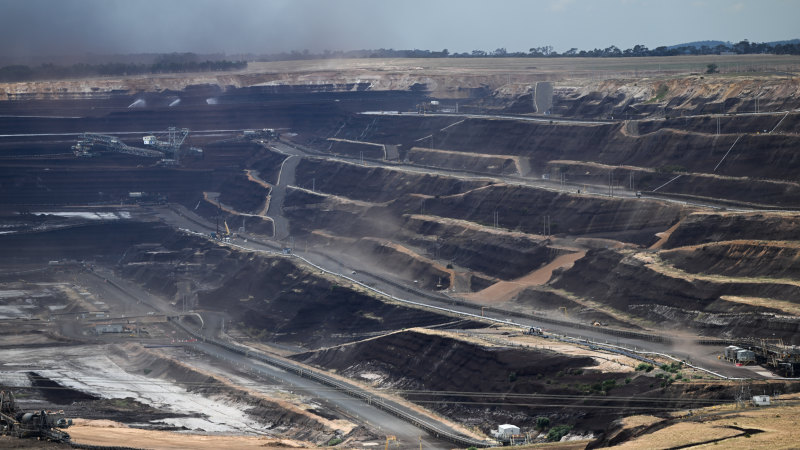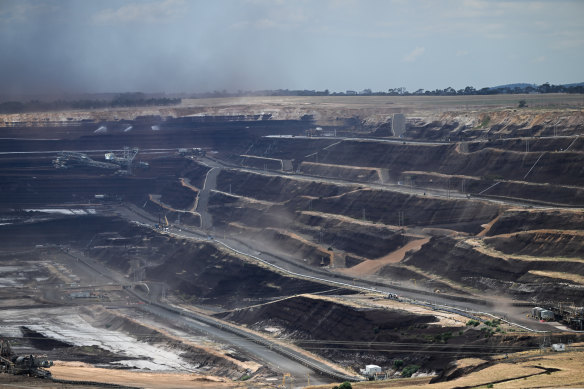Save articles for later
Add articles to your saved list and come back to them any time.
Australia has been called out for underreporting its annual greenhouse gas pollution by as much as 28 million tonnes by failing to record more than 80 per cent of emissions that leak during coal and gas production, exacerbating the challenge of achieving the government’s upgraded climate targets.
The Paris-based International Energy Agency, which conducts independent analysis of greenhouse emissions using public data including satellite detection, estimates that in 2022 Australia’s coal mines were responsible for about 81 per cent more fugitive methane emissions than official statistics show, while oil and gas production generated 92 per cent more.
Coal mining is a major source of fugitive methane emissions.Credit: Joe Armao
According to the federal government, Australia’s coal and gas production leaks about 33 million tonnes of fugitive methane into the atmosphere during coal and gas production a year.
The Institute for Energy Economics and Financial Analysis (IEEFA) published a report on Wednesday that analysed the IEA figures reported in its global methane tracker.
The analysis said the energy agency, an intergovernmental organisation of which Australia is a member, identified a total of 28 million tonnes of uncounted fugitive greenhouse gases in the country in 2022. That is roughly 6 per cent of the national total, according to the most recent annual count of 487 million tonnes.
“This highlights the need for urgent action to improve methane emissions monitoring in Australia and to develop a plan to address domestic methane emissions,” IEEFA’s report said.
University of Melbourne honorary professorial fellow Peter Rayner, currently working at the not-for-profit Superpower Institute, said the IEA data was credible and should be incorporated into the government’s reports.
Data used by the IEA is produced by measuring atmospheric methane and tracing emissions plumes by analysing wind patterns to locate the sites of fugitive emissions. The government figures are largely compiled with data provided by miners and gas producers, which are required to report their emissions.
“I think it is the government doing the best it can, but it’s doing the best it can given that it can’t go out and actually collect local data,” Rayner said.
“The IEA numbers are probably a closer fit to what’s actually going into the atmosphere. It would be wise for the government to incorporate independent observations.”
A spokesperson for Climate Change and Energy Minister Chris Bowen said the government’s emissions reporting is subject to extensive domestic and international reviews to provide confidence in its accuracy.
“Australia’s National Greenhouse Gas Inventory is compiled consistent with the United Nations Framework Convention on Climate Change and Paris Agreement rules and guidance on emissions estimates,” the spokesperson said.
The government has asked its Climate Change Authority to look at ways of improving methane measurement.
Incorporating a greater volume of fugitive greenhouse emissions into the national figures would add to the challenge of reaching Australia’s climate commitments. They include a legally binding target to cut national emissions by 43 per cent by 2030 and reach net zero by 2050, as well as a 2022 commitment to the Global Methane Pledge to cut emissions of the gas to 30 per cent below 2020 levels by the end of the decade.
Amandine Denis-Ryan, chief executive of the IEEFA and author of the report, said the underreporting also means the emissions targets under the federal government’s safeguard mechanism would need to nearly double from cuts of 4.9 per cent to 9.8 per cent a year.
The safeguard mechanism applies to the 215 industrial polluters that generate more than 100,000 tonnes of greenhouse gas a year, including many coal and gas producers. These polluters are required to reduce their emissions by about 4.9 per cent a year until the end of the decade.
Cut through the noise of federal politics with news, views and expert analysis from Jacqueline Maley. Subscribers can sign up to our weekly Inside Politics newsletter here.
Most Viewed in Politics
From our partners
Source: Read Full Article


